Global high-mix volume high-speed PCBA manufacturer
9:00 -18:00, Mon. - Fri. (GMT+8)
9:00 -12:00, Sat. (GMT+8)
(Except Chinese public holidays)
Global high-mix volume high-speed PCBA manufacturer
9:00 -18:00, Mon. - Fri. (GMT+8)
9:00 -12:00, Sat. (GMT+8)
(Except Chinese public holidays)
HomePage > Blog > Knowledge Base > A Complete Guide to PCB Materials and Components
Whether it is the micro motherboard of a smartphone or the navigation system in a space probe, the printed circuit board (PCB) is almost the core component of all electronic devices. They are hidden in unseen places and govern every startup and every operation instruction of the device. A seemingly ordinary circuit board actually integrates a precise material structure and a complex electronic component system behind it. So, what is a PCB made of? Next, this article will introduce it to you from two aspects: PCB materials and PCB components.
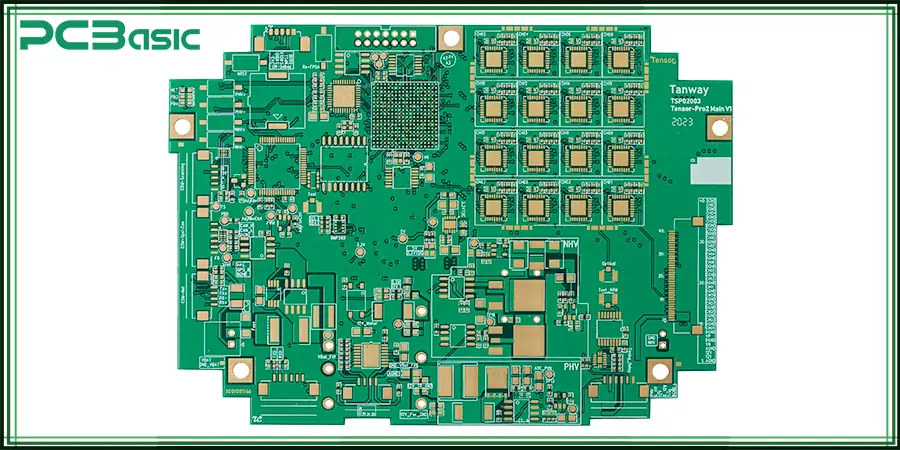
PCB is the fundamental platform for the operation of almost all modern electronic devices. PCB (material) provides mechanical support and electrical connection for various electronic components, and is the key carrier for converting raw electrical signals into actual functions.
A typical circuit board is composed of multiple layers of circuit board materials, including the insulating substrate, copper foil traces, solder mask layers and various surface treatment layers. Although PCB components such as resistors, capacitors, ICs, connectors, etc. determine the function of the circuit, what truly determines the stability, reliability and manufacturability of the product is the selected PCB material. Understanding the structure of PCB boards and the components of a circuit board are equally important for a good, complete and efficient circuit board design. We can say:
PCB = Function (Components) + Structure (Materials)
PCB materials can largely determine the performance and reliability of a printed circuit board. Each layer of material on a PCB has its specific functions. Then, the following section provides a detailed overview to several major types of circuit board materials and their technical characteristics.
The PCB substrate material is the lowest layer that constitutes the circuit board. This layer is mainly used to provide mechanical strength and electrical insulation for the PCB. The most commonly used PCB board material is FR4. FR4 is a flame-retardant glass fiber epoxy resin material, featuring low cost and stable performance. It is the preferred material for most consumer electronics.
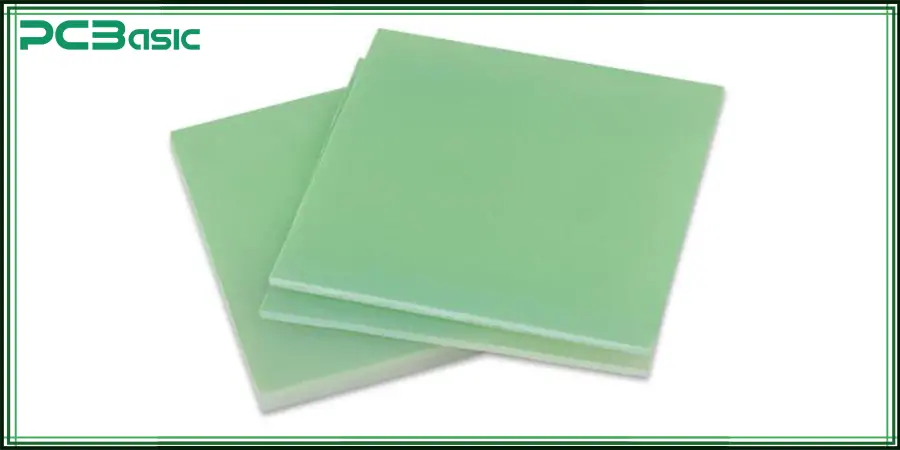
For applications that require high power or heat dissipation performance, metal core PCB materials, such as aluminum substrates, are often selected because they have excellent thermal conductivity. In scenarios that require flexible design, such as wearable devices and spacecraft, polyimide (PI) type flexible PCB materials will be used.
If the circuit needs to transmit high-frequency or radio frequency signals, Rogers PCB material is recommended. Because this type of material has the characteristic of low dielectric loss, it is an ideal choice for the design of radio frequency (RF) and microwave circuits. Understanding these different PCB material types is crucial for reasonable selection and reliable design.
The conductive layer of a PCB is usually composed of copper foil, forming the signal path on the circuit board. Depending on the complexity of the design, these copper layers can be part of a single-sided, double-sided or multi-layer structure.
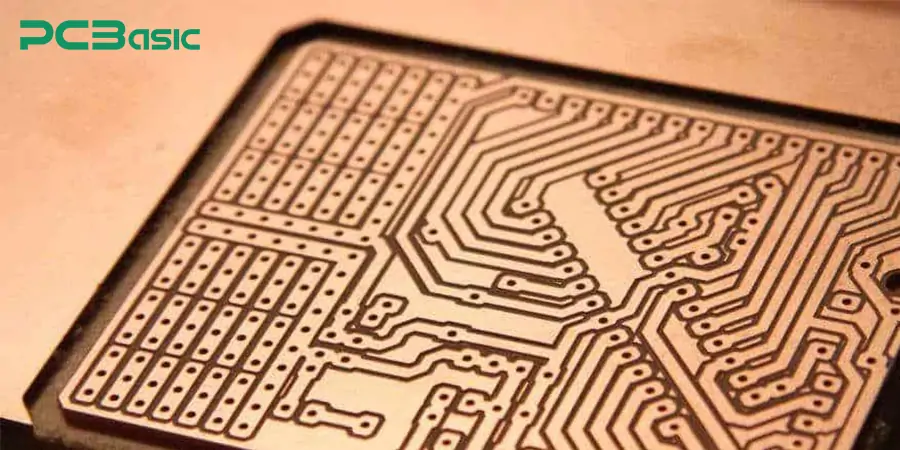
The thickness of copper foil (usually expressed in oz/ft²) determines its current-carrying capacity and thermal conductivity. In high-power or high-speed signal applications, the reasonable selection of copper thickness is the key to ensuring the power transmission capacity and signal integrity.
The dielectric layer plays a role in isolating the conductive copper layer in the PCB. It is often composed of prepreg and core material. These dielectric materials not only ensure electrical insulation but also affect the impedance characteristics during the signal transmission process.
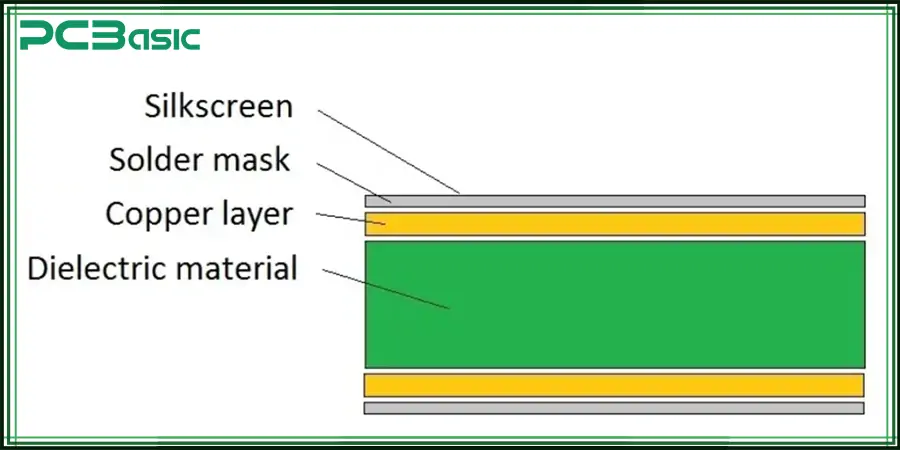
The dielectric constant (Dk) of the selected material will determine the propagation speed of the signal within the board. Therefore, for high-speed or RF applications, PCB laminate materials with low Dk must be selected to reduce signal loss and improve the overall transmission performance. The higher the electrical performance requirements are, the more cautious the material selection needs to be.
The outermost layer of a PCB, or the protective layer, consists of a solder mask, a silkscreen and a surface finish. These layers are usually located above the copper layer, which can not only protect the circuit board but also enhance the identifiability and soldering performance of the PCB.
The solder mask is commonly green, but it can also be black, white, red, etc. Its function is to cover the copper foil to prevent short circuits during the soldering process and it is an indispensable layer in the process of PCB components assembly.
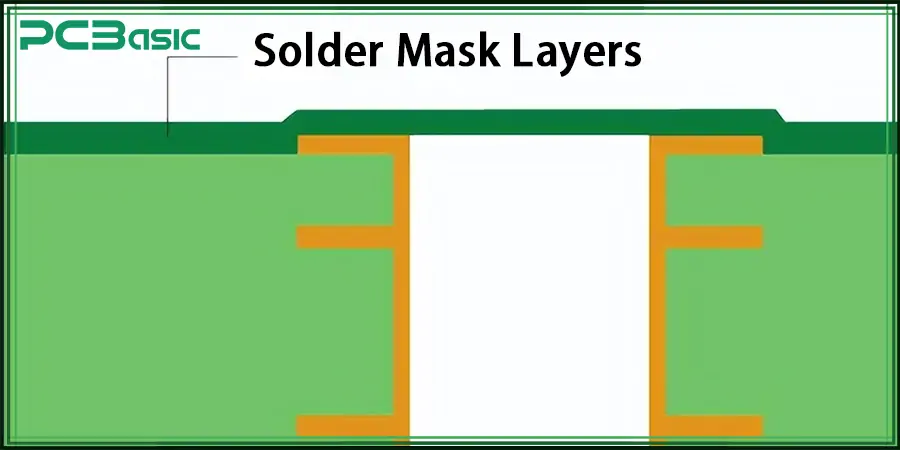
The silkscreen layer is printed with device number, position number, identification and other information, which facilitates inspection, maintenance and accurate soldering of PCB components.
Common surface finish methods include HASL, ENIG and OSP, which can enhance solderability and prevent the oxidation of the copper layer.
These protective layers play a significant role in enhancing the reliability, durability and manufacturability of PCBs.
|
Category |
Material Name |
Main Function |
Application Scenario |
|
Substrate Materials |
FR4 (Fiberglass Epoxy) |
Structural support, electrical insulation |
Consumer electronics, general-purpose PCBs |
|
Aluminum/Copper Core (MCPCB) |
High thermal conductivity |
LED lighting, power modules, high-heat applications |
|
|
Polyimide (PI) |
Flexibility, high-temperature resistance |
Wearables, FPC, aerospace products |
|
|
Ceramic Substrate (Al₂O₃ / AlN) |
Ultra-high thermal conductivity, insulation, stability |
High-frequency, high-power, automotive electronics |
|
|
Rogers Laminate |
Low dielectric loss, excellent signal integrity |
High-frequency communication, RF, microwave, 5G |
|
|
Teflon (PTFE) |
Low loss at high frequencies, excellent stability |
High-speed boards, radar systems, military electronics |
|
|
BT Resin (Bismaleimide Triazine) |
High frequency performance, thermal stability |
Communication base stations, high-speed backplanes, critical systems |
|
|
Conductive Materials |
Electrolytic Copper Foil (ED Copper) |
Signal transmission, power delivery |
All PCB circuit layers |
|
Rolled Annealed Copper Foil (RA Copper) |
Excellent ductility and flexibility |
Flexible circuits, rigid-flex boards, FPC cabling |
|
|
Dielectric Materials |
Prepreg |
Layer bonding and insulation in multilayer boards |
Multilayer PCB stack-ups |
|
Core |
Electrical insulation, thickness control |
Internal structure of multilayer PCBs |
|
|
Protective Materials |
Solder Mask |
Short-circuit prevention, oxidation resistance, aesthetics |
All PCB surfaces |
|
Silkscreen Ink |
Component labeling, reference marking |
Component positioning, assembly, maintenance |
|
|
Surface Finishes |
HASL (Hot Air Solder Leveling) |
Enhanced solderability, oxidation prevention |
General pad protection, through-hole soldering |
|
ENIG (Electroless Nickel Immersion Gold) |
Flatness, corrosion resistance, fine-pitch capable |
BGA, QFN, server motherboards |
|
|
OSP (Organic Solderability Preservative) |
Good solderability, eco-friendly, flat surface |
SMT boards, lead-free boards, RoHS-compliant products |
|
|
Immersion Silver |
Excellent conductivity, ideal for high-speed signals |
High-frequency PCBs, high-speed digital boards |
|
|
Immersion Tin |
Flat surface, suitable for fine-pitch pads |
High-density SMT boards, precision control circuits |
|
|
Gold Plating |
Wear resistance, suitable for frequent connections |
Gold fingers, connector contacts, power modules |
|
|
Special Materials |
Teflon (PTFE) |
Low loss at high frequencies, excellent dielectric performance |
Radar, 5G communication, microwave circuits |
|
BT Epoxy Resin |
High thermal stability, consistent electrical performance |
Aerospace, high-speed backplanes, satellite systems |
PCB components are key electronic devices installed on PCBs to achieve specific electrical functions. Ranging from the most basic passive devices (such as resistors and capacitors) to complex active devices (such as microcontrollers, transistors, and power ICs), they jointly constitute the core of electronic circuits.
Common types of PCB components include: passive components (resistors, capacitors, inductors, etc.), active components (diodes, transistors, integrated circuits), motor/connection components (connectors, relays, switches), and auxiliary devices, etc.
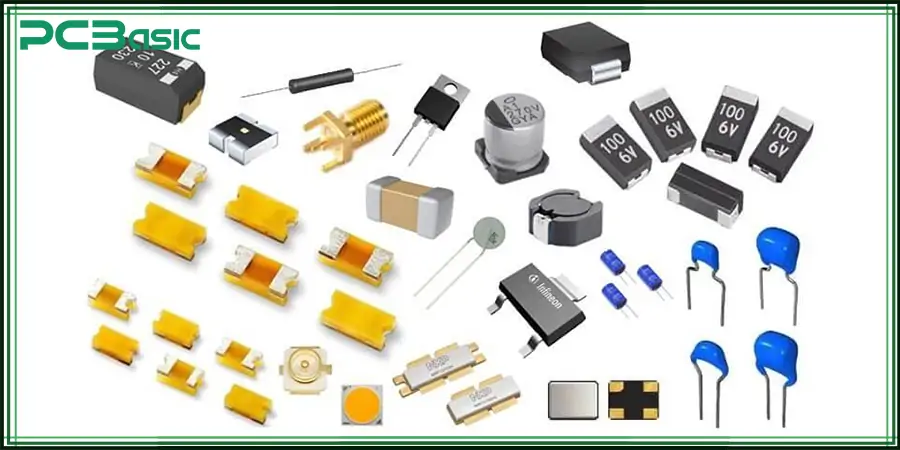
Before assembling PCB components, a detailed PCB components list is required. The list is usually included in the BOM (Bill of Materials), which needs to list the model, specification, package, quantity and manufacturer's part number of each component. This list is crucial for the procurement, production and quality inspection processes. To make a good list, one must first have a clear understanding of the PCB components.
The following table lists the common component names, functions, and application scenarios.
|
Category |
Component Name |
Function Description |
Typical Application |
|
Passive Components |
Resistor |
Controls current, divides voltage |
Basic in all types of circuits |
|
Capacitor |
Stores energy, filters signals, signal coupling |
Power filtering, signal isolation |
|
|
Inductor |
Stores energy, filters noise, suppresses interference |
DC-DC converters, signal processing |
|
|
Ferrite Bead |
Suppresses high-frequency noise, improves EMI performance |
Power input filtering, audio, RF interfaces |
|
|
Active Components |
Diode |
Unidirectional conduction, reverse polarity protection, rectification |
Power input, signal rectification |
|
LED (Light Emitting Diode) |
Provides visual indication |
Power/status indicator |
|
|
Transistor |
Amplifies signals, switching control |
Signal amplification, logic control |
|
|
IC (Integrated Circuit) |
Performs complex logic, computation, signal processing |
Microcontrollers, amplifiers, drivers, RF chips |
|
|
Voltage Regulator |
Provides stable voltage output |
Power modules, battery management systems |
|
|
I/O and Control Components |
Connector |
Provides electrical connections between boards or wires |
USB, HDMI, pin headers, FPC connectors, SATA |
|
Switch |
Manual on/off control |
Power button, reset switch, DIP switch |
|
|
Relay |
Uses small current to control large current |
Industrial control, power switching |
|
|
Buzzer |
Generates sound or beep signal |
Alarms, timers, status feedback |
|
|
Crystal / Oscillator |
Provides precise clock frequency |
MCU timing, wireless, communication modules |
|
|
Mechanical & Support |
Heatsink |
Dissipates heat, protects components |
High-power ICs, LED drivers, power amplifiers |
|
Mounting Hole / Positioning Hole |
Mechanical support and alignment |
Enclosure assembly, connector alignment |
|
|
Fuse |
Overcurrent protection |
Power input, sensitive circuit protection |
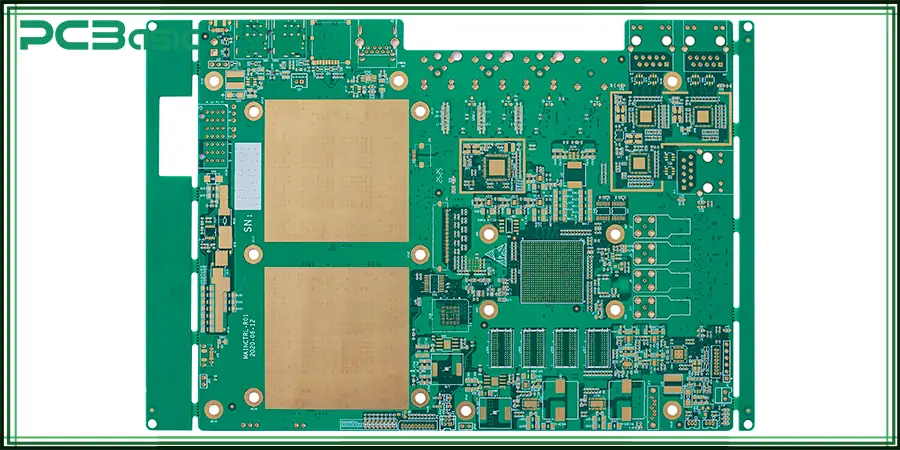
The close collaboration between PCB materials and PCB components determines the performance and reliability of the circuit board. The components on the circuit board determine the functional logic of the circuit. The circuit board materials determine the structural strength, electrical characteristics and their adaptability to the external environment. The PCB substrate provides mechanical support and electrical insulation, ensuring that the circuit board maintains its shape and avoiding the risk of short circuits. The copper layers on the substrate serve as conductor paths, connecting different PCB components and achieving signal and power transmission through traces and vias.
For example, for PCBs used in 5G communication or radio frequency equipment, low-loss dielectric materials such as Rogers or PTFE materials and precise component arrangement are required to avoid signal distortion or electromagnetic interference problems. Only by rationally selecting PCB materials and effectively combining them with appropriate PCB electronic components during the design and soldering processes can the best balance of performance, reliability and manufacturing efficiency be achieved.
PCB is a fusion of function and structure. Only by having a thorough understanding of the relationship between circuit board materials and circuit board components can more stable, manufacturable and superior electronic products be designed. Whether you are preparing to solder PCB components, planning PCB assembly, or choosing the right PCB substrate material, all must have a comprehensive understanding of PCB materials and PCB components.
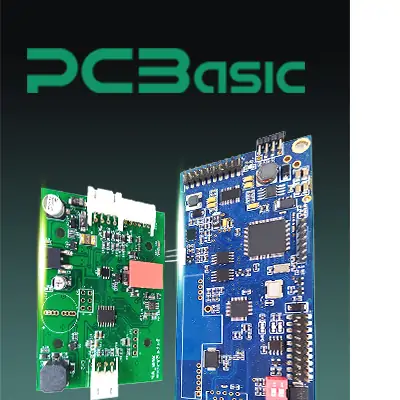 About PCBasic
About PCBasic
Time is money in your projects – and PCBasic gets it. PCBasic is a PCB assembly company that delivers fast, flawless results every time. Our comprehensive PCB assembly services include expert engineering support at every step, ensuring top quality in every board. As a leading PCB assembly manufacturer, we provide a one-stop solution that streamlines your supply chain. Partner with our advanced PCB prototype factory for quick turnarounds and superior results you can trust.
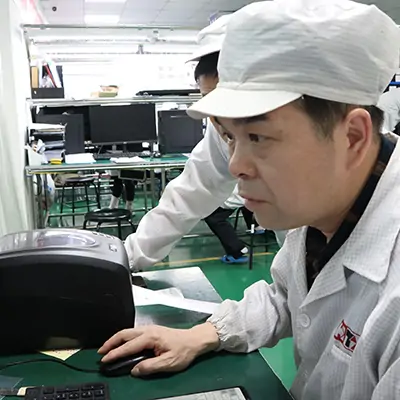
Assembly Enquiry
Instant Quote
Phone contact

+86-755-27218592
In addition, we've prepared a Help Center. We recommend checking it before reaching out, as your question and its answer may already be clearly explained there.
Wechat Support

In addition, we've prepared a Help Center. We recommend checking it before reaching out, as your question and its answer may already be clearly explained there.
WhatsApp Support

In addition, we've prepared a Help Center. We recommend checking it before reaching out, as your question and its answer may already be clearly explained there.
